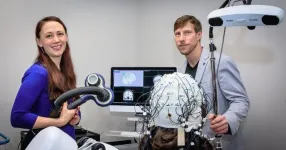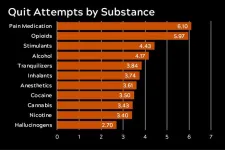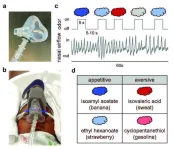Researchers uncover new approach to predict pain sensitivity
2025-01-27
In an international effort, researchers at Western University, the University of Maryland School of Dentistry (UMSOD) and Neuroscience Research Australia (NeuRA) uncovered how specific patterns in brain activity can predict an individual’s sensitivity to pain, expanding opportunities for improved pain management strategies.
The new study was published Jan. 27 in JAMA Neurology. It found the combination of two biomarkers in the brain – corticomotor excitability (CME), excitability in the region of the brain that controls movement, and peak alpha frequency (PAF), a neural marker associated with cognitive performance – can accurately and reliably distinguish high- ...
‘Embodied energy’ powers modular worm, jellyfish robots
2025-01-27
ITHACA, N.Y. – In the same way that terrestrial life evolved from ocean swimmers to land walkers, soft robots are progressing, too, thanks to recent Cornell University research in battery development and design.
A modular worm robot and jellyfish demonstrate the benefits of “embodied energy” – an approach that incorporates power sources into the body of a machine, to reduce its weight and cost.
The worm and jellyfish are direct descendants of an aqueous soft robot, inspired by a lionfish and unveiled in 2019, that could store energy and power its applications via a circulating hydraulic fluid – i.e., “robot blood.” Similar blood sustains ...
Hebrew SeniorLife’s Deanna and Sidney Wolk Center for Memory Health recognized as an age-friendly health system
2025-01-27
Hebrew SeniorLife, New England’s largest nonprofit provider of senior health care and living communities and the only senior care organization affiliated with Harvard Medical School, announces that its Deanna and Sidney Wolk Center for Memory Health has been recognized by the Institute of Healthcare Improvement (IHI) as an Age-Friendly Health System, level 2, Committed to Care Excellence.
To qualify as an Age-Friendly Health System, level 2, the Wolk Center, which provides comprehensive outpatient care related to brain health, cognitive and behavioral problems, and memory loss, whether due to Alzheimer’s disease, other dementias, or other neurological or psychiatric ...
Scientists develop ultra-thin absorbers with record-breaking bandwidth
2025-01-27
Absorbing layers have been fundamental to advancements in technologies like energy harvesting, stealth systems, and communication networks. These absorbers efficiently capture electromagnetic waves across broad frequency ranges, enabling the development of sustainable, self-powered devices such as remote sensors and internet of things (IoT) systems. In addition to energy applications, these layers are pivotal in stealth technology, where they minimize radar visibility and enhance the performance of aircraft and naval systems. They also play a crucial role in improving communication networks by reducing ...
Floating solar increases greenhouse gas emissions on small ponds
2025-01-27
ITHACA, N.Y. – While floating solar – the emerging practice of putting solar panels on bodies of water – is promising in its efficiency and its potential to spare agricultural and conservation lands, a new experiment finds environmental trade-offs.
In the first manipulative field study examining the environmental impacts of floating solar, published in Environmental Science and Technology, researchers found that floating solar panels increased greenhouse gas emissions on small ponds by nearly 27%.
“There ...
Cancer risk established before birth
2025-01-27
GRAND RAPIDS, Mich. (Jan. 27, 2025) — A person’s lifetime risk for cancer may begin before they are even born, reports a paradigm-shifting study by Van Andel Institute scientists.
The findings, published in Nature Cancer, identified two distinct epigenetic states that arise during development and are linked to cancer risk. One of these states is associated with a lower lifetime risk while the other is associated with a higher lifetime risk.
If cancer does develop in the lower risk state, it ...
Sinking truths: University of Houston confirms Miami’s coastal subsidence challenges
2025-01-27
On the barrier islands of Miami, 35 skyscrapers – including Trump Tower III - have sunk as much as eight centimeters, or three inches, into the ground since 2016, and researchers from the University of Houston have played a pivotal role in uncovering the reason why – urban development.
The findings, published in Earth and Space Science, reveal alarming rates of subsidence – or land sinking – in coastal structures between 2016 and 2023.
According to the report, "About half of the subsiding structures are younger than 2014 and at the majority of them subsidence decays with ...
Sun receives funding for CyberCorps scholarship for service
2025-01-27
Kun Sun, Professor, Information Sciences and Technology, Center for Secure Information Systems, College of Engineering and Computing (CEC), received funding for: “CyberCorps Scholarship for Service: EAGLE: Empowering American Government Leadership in Cybersecurity through Education.”
Due to the proliferation of cyber-attacks, the ...
If at first you don’t succeed: Virginia Tech researchers ask how many attempts it takes to quit substance abuse
2025-01-27
Relapse is common when someone is trying to quit, regardless of whether they’re giving up opioids or alcohol or cigarettes.
To better inform treatment, researchers with the Fralin Biomedical Research Institute at VTC’s Addiction Recovery Research Center wanted to better understand how the experience of quitting differed across substances.
“When we talk about intervention for addiction, we know that we are far from the ideal model of treatment,” said Rafaela Fontes, a research scientist at the Fralin Biomedical Research Institute and first author on the study, “Beyond ...
Characterizing olfactory brain responses in young infants
2025-01-27
The sense of smell promotes adaptive behaviors such as feeding and soothing, but how early humans begin to process odors represents a gap in knowledge for researchers. In a new study in JNeurosci, Thorsten Kahnt from the National Institute on Drug Abuse and colleagues explored olfaction development in humans and reveal how early humans begin to smell. The researchers used fMRI to image the brains of sleeping infants as they inhaled appetitive (pleasant) and aversive (unpleasant) odors. As early as one month of age, odors triggered activity in brain regions strongly associated ...
Underwater mud volcanos are a haven for marine organisms
2025-01-27
The underwater volcano Borealis Mud Volcano is located in the Barents Sea and was first discovered by researchers at UiT The Arctic University of Norway in 2023. The discovery received a lot of attention, and images of the volcano circulated around the world. Now researchers from UiT, in collaboration with REV Ocean, have finally published the results from an interdisciplinary investigation showing that Borealis mud volcano has a unique ecological role as a natural sanctuary for several marine species in the Barents Sea.
While some parts of the ...
Adderall shortage may be associated with increased use of alternative ADHD medication in children
2025-01-27
A national shortage in a common treatment for attention-deficit hyperactivity disorder was associated with changes in stimulant prescriptions filled for children over recent years, a new study suggests.
The dispensing of prescription stimulants – a crucial therapy option for children with ADHD – fell sharply at the onset of the 2020 COVID pandemic but then began to recover, according to the research in Pediatrics.
The Federal Drug Administration’s announcement of a shortage in the stimulant Adderall in October ...
Skin cancer: New treatment option successfully tested
2025-01-27
Basal cell carcinomas, the most common form of skin cancer, occur in chronically sun-exposed areas such as the face. Locally advanced tumours in particular can be difficult to treat surgically. A research team from MedUni Vienna and University Hospital Vienna has now investigated the effectiveness of a new type of therapy and achieved promising results: The active substance TVEC led to a reduction in the size of the basal cell carcinoma in all study participants, which not only improved surgical removal, but also ...
Tracking cfDNA release dynamics during colorectal cancer surgery
2025-01-27
“Taken together, our results suggest that in addition to physiological age, comorbidities and unfavorable clinical traits, intense surgical manipulation from the tumor’s extent, may result in greater tissue damage and elevated cfDNA release.”
BUFFALO, NY – January 27, 2025 – A new research paper was published in Oncotarget’s Volume 16 on January 21, 2025, titled “Assessment of cfDNA release dynamics during colorectal cancer surgery.”
Researchers from the University of Brasília investigated how cell-free DNA (cfDNA) levels in the blood change before, during, and after colorectal cancer surgery. ...
Climate study: Rise in heat deaths will substantially outweigh fewer cold deaths
2025-01-27
Climate change will likely result in a significant rise in deaths from heat across Europe, substantially surpassing any decrease in cold-related deaths. This trend persists across climate change scenarios and even under high adaptation to heat, reinforcing the need for aggressive mitigation policies.
A modelling study, led by researchers from the Environment & Health Modelling (EHM) Lab at the London School of Hygiene & Tropical Medicine (LSHTM) and published in Nature Medicine, estimates that changes to the climate could directly result in over 2.3 million additional temperature-related deaths in 854 European cities by 2099 if urgent action ...
Infant mortality rates declining, but Sudden Unexpected Infant Death is on the rise
2025-01-27
RICHMOND, Va. (Jan. 27, 2025) — Infant mortality in the United States decreased by 24.2% between 1999 and 2022. Researchers from Virginia Commonwealth University and Children’s Hospital of Richmond at VCU discovered this improvement in a study published Jan. 27 in the Journal of the American Medical Association Pediatrics. In the same study, however, they found mortality rates from Sudden Unexpected Infant Death (SUID) rose significantly – by 11.8% – from 2020 to 2022.
“Although a prior CDC study – using data until 2020 – found that Sudden Unexpected Infant Death was increasing for Black infants, ...
Severity and long-term mortality of COVID-19, influenza, and RSV
2025-01-27
About The Study: This cohort study showed that, during the 2022 to 2023 season, infection with SARS-CoV-2 was associated with more severe disease outcomes than influenza or respiratory syncytial virus (RSV), whereas differences were less pronounced during the 2023 to 2024 season. During both seasons, RSV remained a milder illness, whereas COVID-19 was associated with higher long-term mortality. Vaccination attenuated differences in disease severity and long-term mortality.
Corresponding Author: To contact the corresponding author, Kristina L. Bajema, MD, email kristina.bajema@va.gov.
To access the ...
Firearm-related injury hospital admissions during the COVID-19 pandemic
2025-01-27
About The Study: This cohort study evaluating hospitalizations for firearm-related injuries during the COVID-19 pandemic has 2 principal findings. From 2020 to 2021, there was a 34% increase in firearm-related hospitalizations, consistent with an additional 13,268 admissions. Second, the increase in firearm-related hospitalization disproportionately affected children, patients enrolled in Medicaid, and Black individuals. Taken together, these findings raise new concerns about the sustained increase in firearm-related injury that disproportionately ...
Sudden unexpected infant death and disparities in infant mortality in the US
2025-01-27
About The Study: This study found that infant mortality from sudden unexpected infant death (SUID) has increased significantly. Previous data through 2020 showed that SUID increased among Black infants. The current analysis, which included 2021 and 2022 data, showed a more generalized increase. Possible explanations include COVID-19 or other respiratory illnesses, maternal opioid use, and social media’s influence on infant sleeping practices.
Corresponding Author: To contact the corresponding author, Elizabeth R. Wolf, MD, ...
Predicting individual pain sensitivity using a novel cortical biomarker signature
2025-01-27
About The Study: This study provides evidence for a sensorimotor cortical biomarker signature for pain sensitivity. The combination of accuracy, reproducibility, and reliability suggests the peak alpha frequency/corticomotor excitability biomarker signature has substantial potential for clinical translation, including predicting the transition from acute to chronic pain.
Corresponding Author: To contact the corresponding author, David A. Seminowicz, PhD, email dseminow@uwo.ca.
To access the embargoed study: Visit our For The Media website at this ...
Firearm-related hospitalizations had dropped before the pandemic, then shot up, study finds
2025-01-27
Firearm injuries that sent victims to the hospital had gone down steadily over the five years before the COVID-19 pandemic began, but reversed course sharply over the next two years, a new University of Michigan study finds.
In all, 34% more people were hospitalized for a firearm-related injury in 2020 and 2021 than would have been predicted based on pre-pandemic trends.
The gap between expected and actual hospitalizations was even bigger for patients under the age of 18, those covered by Medicaid insurance for people with low incomes or disabilities, and those who are Black. The study is published in JAMA Network Open.
These ...
Novel organ recovery and logistics company celebrates 500th transplant
2025-01-27
New York, NY – January 27, 2025 – ProCure On-Demand’s 500th transplanted organ, being announced today, is emblematic of the gaps and inefficiencies in the current transplant system that the organ recovery, technology and logistics company is regularly solving.
The case involving the transplant of the 500th organ underscores ProCure's reputation for quality work, efficient logistics and swift turnaround times, which have become integral to their success. With less than five hours to recover bilateral lungs, ProCure tapped into its unique Recovery Team Network, to deploy a surgeon within seven miles ...
New research offers hope for preventing epilepsy after traumatic brain injury
2025-01-27
Monday 27 January, 2025: A new international study has unveiled critical insights in understanding post-traumatic epilepsy (PTE), a condition that can develop following traumatic brain injury. Led by researchers at FutureNeuro, the Research Ireland Centre for Translational Brain Science and RCSI University of Medicine and Health Sciences and published in Theranostics, the study highlights the important role played by a receptor in the brain called P2X7. It suggests how we could both reduce epilepsy ...
New measurements of solar radiative opacity thanks to helioseismology
2025-01-27
Researchers have pioneered an innovative method using helioseismology to measure the solar radiative opacity under extreme conditions. This groundbreaking work, published in Nature Communications, not only reveals gaps in our understanding of atomic physics but also confirms recent experimental results, thereby opening new perspectives in astrophysics and nuclear physics.
Helioseismology is a discipline dedicated to studying the Sun's acoustic oscillations, enabling us to probe the interior of our star with remarkable precision. By analysing ...
Cameron G. Duncan, Ph.D., named Dean of FAU Christine E. Lynn College of Nursing
2025-01-27
Florida Atlantic University has named Cameron G. Duncan, Ph.D., DNP, APRN, FNP-C, PMHNP-BC, CNE, FAANP, as the new Holli Rockwell Trubinsky Eminent Dean of the Christine E. Lynn College of Nursing.
Duncan is the fourth dean in the college’s 45-year history and will take the helm on Jan. 27. Prior to joining FAU, he served as the interim dean of the Orvis School of Nursing at the University of Nevada, Reno, where he previously served as the director of the Psychiatric-Mental Health Nurse Practitioner Program since 2017. In his new role at FAU, Duncan will work closely with faculty, staff, and local community partners ...
[1] ... [598]
[599]
[600]
[601]
[602]
[603]
[604]
[605]
606
[607]
[608]
[609]
[610]
[611]
[612]
[613]
[614]
... [8715]
Press-News.org - Free Press Release Distribution service.








